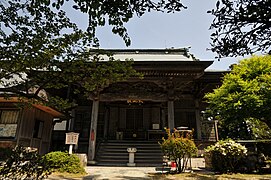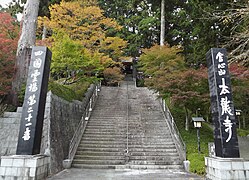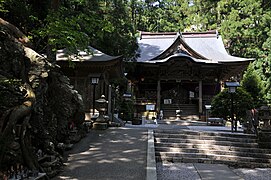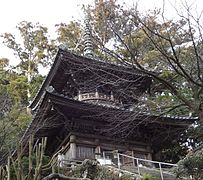Tairyū-ji (Anan)
The Tairyū-ji ( Japanese 太 龍 寺 ) with the Go Shashinzan (舎 心 山) and Jōjūin (常 住院) in the city of Anan ( Tokushima Prefecture ) is a temple that belongs to the Kōyasan direction of Shingon Buddhism . Because of its location high in the mountains, it is also called "Kōya of the West" (西 の 高 野). In the traditional count, it is the 21st temple on the Shikoku pilgrimage route .
history
Priest Kūkai came to this area in 793 at the age of 19 and tried to get enlightenment while sitting on the Tairyū cliff with the help of the "Kokūzō Gumonji" teaching (虚空 蔵 求 聞 持法), whereupon he wrote "Sankyōshiki “(三 教 指 帰) saw in front of you. The rock on which he sat is known as Shashin-Iwa (舎 心 岩).
According to tradition, the temple area is said to have been laid out in 798 at the request of Emperor Kammu by the governor of Awa, Fujiwara no Fumiyama (auf 文山; d. 841). Kūkai is said to have made five sculptures for various temples, starting with the holy Kokūzō. In 1385 the supplicants placed Myōa (便 妙 阿), Jōkei (浄 慶) and other "100 m stones" (丁 石, Chōseki) along the pilgrimage path. The stones begin at Isshuku-ji (一宿 寺) in Shukuidani (宿 居 谷) and lead to the Niō gate. First, 11 stones could be confirmed, which were registered in 1967 as cultural monuments of the prefecture. More stones were found later, so that today we know 18.
In 1993 a cable car (S on the map) was opened, which leads right up to the area and thus facilitates access.
investment
If you pass the temple gate, which is designed here as a Niō gate (仁王 門, Niō-mon), i.e. as a gate with the two temple guards on the right and left of the passage, you pass the Gumonji Hall (求 聞 持 堂), the abbey (本 坊, Hombō), the Goma Hall (護 摩 堂) and the hexagonal Sutrenspeicher (六角 経 蔵 堂, Rokkaku kyōzōdō; in plan 1). Then you go through the bell gate (鐘楼 門, Shōrō-mon; 2) and climb the stairs to the hall dedicated to the temple founder, the Daishidō (大師 堂; 3), pass the treasure pagoda (多 宝塔, Tahōtō; 4) and reach then the main hall (本 堂, Hondō; 5). The whole complex is surrounded by mighty crescent firs and hinoki , several hundred years old .
Treasures
In the Daishidō, starting with the "Seven Wise Men in the Bamboo Thicket" (竹林 の 七賢 人, Chikurin no shichi kenjin) from the Song era , various carvings are kept. Kūkai is said to have donated the "Bonshaku Shintennō gokorei" bell ensemble made of gold bronze (金銅 梵 釈 四 天王 五 鈷 鈴), which dates from the Tang or Song period.
photos
literature
- Tokushima-ken no rekishi sampo henshu iinkai (Ed.): Tairyu-ji . In: Tokushima-ken no rekishi sampo. Yamakawa Shuppan, 2009. ISBN 978-4-634-24636-2 . Pages 224 and 226.
- Oguri, Doei: Kukai. Shikoku hachijuhachi kosho no arukikata. Chukei no Bunko, 2011. ISBN 978-4-8061-4067-2 .
Web links
Coordinates: 33 ° 52 ′ 57.1 ″ N , 134 ° 31 ′ 18.8 ″ E
← Previous Temple: Kakurin-ji | Tairyū-ji (Anan) | Next temple: Byōdō-ji →








